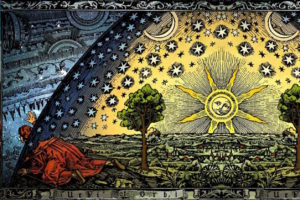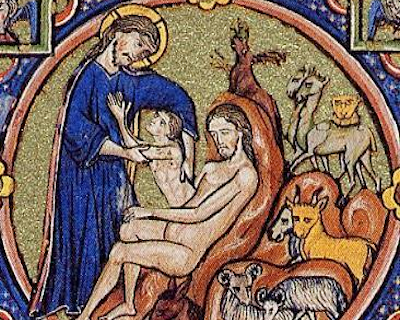
This piece was originally published on Public Orthodoxy, a blog of the Orthodox Christian Studies Center of Fordham University.
In a recent essay published in The Wheel, Dr. Katherine Kelaidis compares contemporary understandings of transgender experience with the specter of “Gnosticism,” an early heresy that takes its name from the Greek word gnōsis, meaning “knowledge.” While a full response to this essay goes beyond the scope of a Public Orthodoxy blog post, I wish to explore the author’s charge of “reborn heresy.” As I begin, I should identify two of my own premises.
First, following the theologians of the Paris School, I categorize Orthodox teachings under several levels of interpretive authority: the dogmatic pronouncements of the ecumenical councils, the theologoumena (learned theological opinions) of the Fathers, and the personal theological opinions of later theologians. Of these sources, only the dogmatic declarations of the ecumenical councils are universally recognized as unchanging. These teachings deal with Trinitarian and Christological controversies of salvific importance, find support by the evidence of Scripture, and enjoy the consensus of the entire Orthodox Church. A teaching contradicting any element of these ecumenical declarations constitutes heresy, a position beyond the bounds of the Orthodox faith. Some go further, suggesting that the teaching’s adherents must obstinately resist correction. Either way, the bar for declaring an idea heretical is very high.
Second, I follow the theological and scholarly distinction between the second century group known as “gnostics” (Greek gnōstikoi) and the modern category of “Gnosticism.”
In his Detection and Overthrow of Gnōsis, Falsely So Called, Irenaeus of Lyons describes a rival school of thought (a hairesis, from which we would later derive the word heresy) known as Valentinians and a group with similar teachings who referred to themselves as “gnostics.”
With the 1945 discovery of a trove of ancient texts at Nag Hammadi, scholars have identified Irenaeus’s gnostics with a text in which the group call themselves “seed of Seth.” From this designation, scholars sometimes refer to the group as Sethian gnostics or Sethians.
Both Valentinians and Sethians were dualists, drawing a sharp distinction between the superior spiritual and inferior physical worlds as well as between the spirit and the body. Irenaeus describes an elaborate cosmology the groups shared in which an inferior god, known as the Demiurge, fashioned the material cosmos. When we confess belief in God the Father as Almighty (Greek pantokrator, literally “ruler of all”), maker of heaven and earth and of all things visible and invisible, we refute the gnostic teaching that a lesser deity created and rules over the material world.
In contrast, “Gnosticism” is a term coined in the 17th century by English philosopher Henry More. In More’s usage, Gnosticism refers to a collection of ancient schools of thought and their texts, grouped for study according to a shared set of characteristics rather than describing any one group’s beliefs.
Since More first coined the term, scholars have proposed a variety of criteria for including various groups or teachings under the banner of Gnosticism. These include a secret knowledge known only by a privileged elite, the idea that humans are divine sparks that have descended into matter and must be freed to return to the spiritual world, and the idea that the divine (or Wisdom) has descended into the created order to awaken these trapped sparks and lead them back home.
Thus, modern “Gnosticism” as a category is not synonymous with the teachings of the Sethian gnostics or the Valentinians. Further, with so many competing definitions, some scholars have suggested that it may be better to simply retire the term.
In her essay, Dr. Kelaidis claims that the gnostics believed that Jesus did not actually take on human flesh, but only seemed to. This teaching, referred to as the heresy of Docetism (from the Greek dokein meaning “to seem”), was a feature of some early Christian groups that have been lumped under many of the proposed definitions of “Gnosticism.” Returning to the Creed, when we confess that Jesus Christ came down from heaven, was incarnate of the Holy Spirit and the Virgin Mary, became a human being, suffered, was buried, and rose again, we recite a refutation of Docetism.
However, the Sethian gnostics were not Docetists. Rather, like Nicene Christians, they affirmed the human corporeality of their savior.
I rehearse these moments to support my primary theological contention with Dr. Kelaidis’s essay. At no point can anyone who understands these facts argue in good faith that contemporary transgender individuals and their supporters are gnostics, “new gnostics,” or heretics more generally.
Orthodox transgender people and their Orthodox cisgender supporters (along with a host of other Christians both trans and cis) faithfully affirm the anti-gnostic elements of the Creed. We are neither Sethians nor Valentinians. We make no claims that the world was created by an inferior deity.
Beyond these narrow, second and third century teachings, we make no claims that the Incarnation of Christ only “seemed” to have material reality. We claim no elite secret knowledge required for salvation. We deny neither the initial goodness of God’s creation nor the effects of the fall on both human nature and the entire created order. We neither profess to be divine sparks trapped in the physical world nor are we seeking escape to a noncorporeal realm.
Dr. Kelaidis rightly describes the pervasive distrust of human bodies espoused by a variety of groups in the ancient world. In the context of pain, disease, injury, aging, and death, it is completely understandable that people of many different schools of thought would share this sentiment. Many early Christians looked for ways that God is at work in our flesh. However, questioning our postlapsarian embodiment, both then and now, is not a heresy. Characterizing gender identity as “a kind of secret knowledge,” Dr. Kelaidis insinuates a link between this knowledge and the gnōsis of heretics. But her wordplay cannot create a heresy either. Finally, Dr. Kelaidis implies that if trans people claim to only outwardly “seem” to be of a particular gender, this somehow makes them Docetists. But her claim, a category error conflating docetic denial of material incarnation with the gender dissonance experienced by many trans people, also fails to detect a heresy.
It is not uncommon for Orthodox polemicists to adopt a strategy of comparing current movements or ideas with teachings previously condemned as heretical. Such accusations can short circuit dialogue and foreclose potential avenues of understanding of our shared human condition. In this particular case, the claim of reborn heresy is also simply false.
Suggestions for further reading:
The Gnostics: Myth, Ritual, and Diversity in Early Christianity by David Brakke
What is Gnosticism? by Karen L. King
Irenaeus of Lyons: Identifying Christianity by John Behr
Understanding Transgender Identities: Four Views edited by James K. Beilby and Paul Rhodes Eddy




